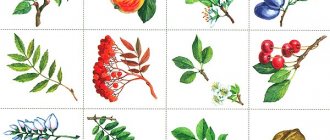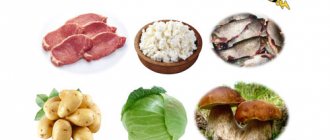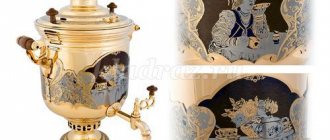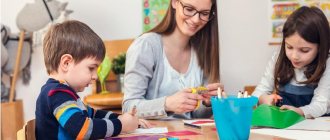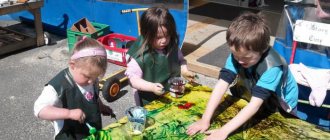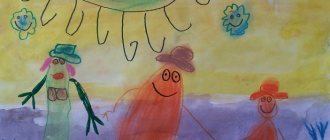Summary of rhythm lessons in the senior group of preschool educational institutions
Summary of a rhythm lesson in the senior group of kindergarten
Target:
create conditions for the formation of the foundations of a healthy lifestyle through the activation of children’s physical activity and the development of interest in creative activities.
Objectives:
to improve skills in the field of musical-rhythmic movements, develop an ear for music, a sense of rhythm, attention, creative imagination, activity, independence and initiative in musical-rhythmic movements;
cultivate the need for a healthy lifestyle; help improve physical and mental health. Equipment:
audio recordings, scarves, plumes, gymnastic ribbons.
Musical series:
T.I. Suvorov (from the textbook “Dance rhythms for children”); communicative game “You walk, don’t yawn!” words by S. Korotaeva; musical accompaniment “Fun instrumental music for children without words”; song from the film “The Adventures of Pinocchio” by A. Rybnikov (movements from the program “Rhythmic Mosaic” by A.I. Burenina); Irish music or any calm melody; song “The World I Need” music by A. Ermolov, lyrics by S. Zolotukhin.
Progress of the lesson
1.Greeting. Warm-up exercise.
Purpose of the warm-up:
development of spatial orientation skills, development of rhythmic hearing, coordination of movements.
Teacher:
Hello, children! Today you have come to rhythmics, where you will learn to express various musical images through the plasticity of your body, improvise and fantasize to rhythmic music! Let's start our lesson with a warm-up, which will help us warm up and get ready at the beginning of the lesson. So, friends, let's begin! Get your arms, legs and back ready! Head, neck and shoulders! Train your mind and body
Advertisement 29
Let's start warming up with confidence! March parade, musical accompaniment - German folk melody (T.I. Suvorova, disc No. 4/1).
2. Exercise “Tree”.
Purpose of the exercise:
development of skills of smooth hand movements, formation of beautiful posture, development of breathing.
Teacher:
Imagine that you are a tree.
The legs are the trunk and the arms are the branches. Let's depict how a tree lives. A small breeze hid in the thick foliage of the tree. The hands are living branches, they sway slightly, now towards each other, now to the sides. The wind blew stronger, and the branches of the tree swayed more strongly. But then the wind blew with such force that it was difficult for the tree to stand and its branches were bent towards the ground. Hand exercises, musical accompaniment “Organ Grinder” P.I.
Tchaikovsky (T.I. Suvorov, disc No. 4/2) 3. Exercise “Humpty Dumpty”.
Purpose of the exercise:
muscle relaxation.
Teacher:
And we smoothly move on to the character from the English children's fairy tales and poems “Humpty Dumpty”.
4. Game rhythms. Communication game “You walk, don’t yawn!”
Purpose of the game:
development of general motor skills, formation of skills in spatial organization of movements, development of reactivity (ability to respond quickly).
Teacher:
Now let’s stand in a circle.
I offer a communicative game “You walk, don’t yawn!” In the chorus of each verse we go to each count, we clap through the count. Let's try it with music! Communication game “You walk, don’t yawn!”
words by S. Korotaeva, musical accompaniment “Fun instrumental music for children without words.” 5. Exercise with objects.
Purpose of the exercise:
development of smooth hand movements, development of long breathing, ability to perceive and convey a musical phrase in movements.
Teacher:
Let's move on to exercises with objects.
Let's take scarves and talk about them. What scarf? Children's answers: yellow, orange, light, airy, transparent. I just want to rock it! What else can you ride? Children's answers:
on a cloud, on a swing!
Swing the scarf in front of us left and right, gradually lifting it up; swing at the last beat. We’ll also swing the scarf in front of us, only from top to bottom, swing in front of us on the last beat. Then 4 swings with the right hand, 4 swings with the left. Let's spin around and get down on one knee. Exercise with scarves, musical accompaniment - “Venice Night” by M.I.
Glinka (T.I. Suvorova, disc No. 4/2 6. Exercise with plumes.
Purpose of the exercise:
development of spatial orientation, education of rhythmic hearing, formation of coordination of movements, speed of reaction and expressiveness of movements.
Teacher:
In the exercise with plumes, we will alternate sharp and smooth movements with our hands, watch the head turn - first to the right, then to the left in each of the four directions.
Exercise with branches, musical accompaniment - “Euryanthe” by K. Weber (T.I. Suvorova, Olympic sports dances for children, disc No. 2)
7. Igroplasty. Marine figures.
Purpose of the exercise:
development of muscle strength.
Teacher:
Imagine that you are “starfish” and are swimming along the bottom of the Black Sea.
(“Starfish” - lying on your stomach, bending over, arms to the sides, legs apart)
.
And now the dolphins are swimming! (“Dolphin” - lying on your stomach, bending over, hands up in a “lock”)
.
And here come the seahorses! (“Seahorse” - sitting on your heels, hands behind your head)
.
Crabs appeared here! (“Crab” - movement in a standing position, bent over, legs bent apart)
.
Musical accompaniment “Dance with the Birds” by V. Kosma (T. Suvorova, disc No. 6/9)
8. Thematic dance “The bird danced a polka.”
Purpose of the dance:
development of a sense of rhythm, coordination of movements, expressive plasticity, the ability to express emotions in facial expressions and pantomime.
Teacher:
And now you are in the form of dolls from the Karabas-Barabas Theater.
The nature of the movements is puppet-like, comic. We develop the ability to properly tense and relax muscles. Musical accompaniment.
Song from the film “The Adventures of Pinocchio” by A. Rybnikov (movements from the program “Rhythmic Mosaic” by A.I. Burenina) 9. “Game of Tag.”
Purpose of the game:
development of general motor skills, formation of skills in spatial organization of movements, development of reactivity
(ability to respond quickly)
.
Teacher:
Let's play tag to the rhythms of Latin American dance!
Let's choose a tag! A game of tag.
Musical accompaniment - Latin American dance “Tico-Tico” (T.I. Suvorova, Olympic disc No. 2) 10. Creative improvisation. Ri.
Purpose of the game:
developing the ability to freely express creative imagination, enter into different images, and work on relaxation.
Teacher:
We break into pairs and sit opposite each other.
One of you begins to set the movements. The other becomes a “mirror”, and his task is to accurately reflect all the movements of the person asking. He must feel like a reflection, so that from the outside it is impossible to distinguish who sets the movements and who repeats. Rea, overcoming motor awkwardness.
Teacher: Children, look at the kind eyes of our guests and the smiles on their faces!
Let's turn our ribbons into brushes, and let's each draw on our own window a world where there is no evil or sorrow, where there is always spring, where there are smiles every day, a world that everyone needs! Musical accompaniment - the song “The World I Need” music by A. Ermolov, lyrics by S. Zolotukhin.
12. Final part.
Teacher:
You have learned to improvise, create and convey an image in dance. Thank you, you did a very good job today. Goodbye!
